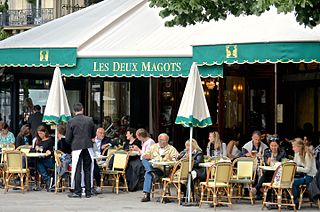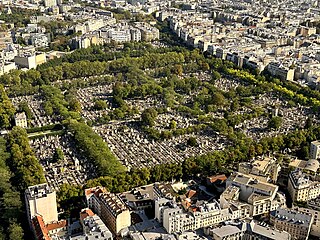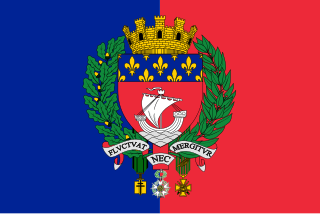
Montmartre is a large hill in Paris's northern 18th arrondissement. It is 130 m (430 ft) high and gives its name to the surrounding district, part of the Right Bank. Montmartre is primarily known for its artistic history, for the white-domed Basilica of the Sacré-Cœur on its summit, and as a nightclub district.
Montparnasse is an area in the south of Paris, France, on the left bank of the river Seine, centred at the crossroads of the Boulevard du Montparnasse and the Rue de Rennes, between the Rue de Rennes and boulevard Raspail. It is split between the 6th, 14th, and 15th arrondissements of the city. Montparnasse has been part of Paris since 1669.

Tour Maine-Montparnasse, also commonly named Tour Montparnasse, is a 210-metre (689 ft) office skyscraper located in the Montparnasse area of Paris, France. Constructed from 1969 to 1973, it was the tallest skyscraper in France until 2011, when it was surpassed by the 231-metre (758 ft) Tour First in the La Défense business district west of Paris's city limits. It remains the tallest building in Paris proper and the third tallest in France, behind Tour First and Tour Hekla. As of July 2023, it is the 53rd-tallest building in Europe.

The 6th arrondissement of Paris is one of the 20 arrondissements of the capital city of France. In spoken French, it is referred to as le sixième.

The 14th arrondissement of Paris, officially named arrondissement de l'Observatoire, is one of the 20 arrondissements of the capital city of France. It is situated on the left bank of the River Seine, containing most of the Montparnasse district. Although today Montparnasse is best known for its skyscraper, Tour Montparnasse, as well as its major railway terminus, Gare Montparnasse, these are both actually located (partly) in the neighbouring 15th arrondissement. The district has traditionally been home to many artists as well as a Breton community, arrived at the beginning of the 20th century upon the creation of the Montparnasse railway terminus.

The 2nd arrondissement of Paris is one of the 20 arrondissements of the capital city of France. In spoken French, this arrondissement is colloquially referred to as deuxième. It is governed locally together with the 1st, 3rd and 4th arrondissement, with which it forms the 1st sector of Paris.

The 15th arrondissement of Paris is one of the 20 arrondissements of the capital city of France. In spoken French, it is referred to as le quinzième.

Montparnasse–Bienvenüe station is a station of the Paris Métro which is a transfer point between Line 4, Line 6, Line 12 and Line 13. The fourth busiest station on the Métro system as of 2019 with 29.9 million riders, it is located in Montparnasse at the intersection of the 6th, 14th and 15th arrondissements.

Edgar Quinet is a station on Line 6 of the Paris Métro. Located at the intersection of Boulevard Edgar Quinet, the Rue du Montparnasse and Rue de la Gaîté, it is situated in the 14th arrondissement.

Duroc is a station on lines 10 and 13 of the Paris Métro. It is located at the point for which the 6th, 7th and 15th arrondissements share a common border, close to the location of an old toll gate on the road to Sèvres, part of the Wall of the Ferme générale, which was built around Paris between 1784 and 1791 by the ferme générale company of tax farmers. The station is named after the nearby rue Duroc, which in turn is named after Géraud Duroc, Duke of Frioul (1772–1813), who was one of Napoleon's generals.
Historical quarters of Paris are areas of Paris, France that have retained an older character, usually identifiable by commercial or cultural activity and often named for a neighborhood landmark. These sections often are not referenced on modern-day maps of Paris, crossing current arrondissements.

Line 4 is one of the sixteen lines of the Paris Métro rapid transit system and one of its three fully automated lines. Situated mostly within the boundaries of the City of Paris, it connects Porte de Clignancourt in the north and Bagneux-Lucie Aubrac in the south, travelling across the heart of the city. Until its southern terminus was changed from Porte d'Orléans to Mairie de Montrouge in 2013, the line was sometimes referred to as the Clignancourt – Orléans Line. At 13.9 km (8.6 mi) in length, it connects with all Paris Métro lines apart from the very short 3bis and 7bis branch lines, as well as with all 5 RER express lines. It also serves three of the Paris Railway stations, Gare du Nord, Gare de l'Est, and Gare Montparnasse. It is the second-busiest Métro line after Line 1, carrying over 154 million passengers in 2004.

Pereire is a station on Line 3 of the Paris Métro located in the 17th arrondissement of Paris.

The Place d'Italie is a public space in the 13th arrondissement of Paris. The square has an average dimension somewhat less than 200 meters in extent, and the following streets meet there:

The Café de la Rotonde is a famous café in the Montparnasse Quarter of Paris, France at 105 Boulevard du Montparnasse, known for its artistic milieu and good food. In its official website, La Rotonde defines itself as a brasserie and restaurant. Located on the Place de Picasso, that also holds the sculpture of Honoré de Balzac by Auguste Rodin called Monument to Balzac at the corner of Boulevard du Montparnasse and Boulevard Raspail, it was founded by Victor Libion in 1911. Based on examples established by La Closerie des Lilas and Le Dôme Café, La Rotonde, along with La Coupole and Le Select, was renowned as an intellectual gathering place for notable artists and writers during the interwar period due to its open atmosphere and reasonable prices. Unlike many establishments in Montparnasse, La Rotonde has retained much of its bohemian charm and continues in operation to this day as a popular and chic spot for classic French cuisine lovers and the Parisian artistic intelligentsia.

Boulevard Raspail is a boulevard of Paris, in France.

Montparnasse Cemetery is a cemetery in the Montparnasse quarter of Paris, in the city's 14th arrondissement. The cemetery is roughly 47 acres and is the second largest cemetery in Paris. The cemetery has over 35,000 graves and approximately a thousand people are buried here each year.
Shamai Haber was a sculptor who lived and worked in Paris, France. He died in 1995 in Paris.
This article presents the main landmarks in the city of Paris within administrative limits, divided by its 20 arrondissements. Landmarks located in the suburbs of Paris, outside of its administrative limits, while within the metropolitan area are not included in this article.

The following outline is provided as an overview of and topical guide to Paris:

















